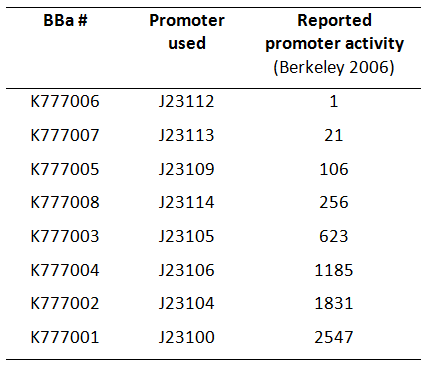Difference between revisions of "Part:BBa K777001"
(→Usage and Biology) |
|||
| Line 16: | Line 16: | ||
* Here is the complete sequence of this part as an [https://static.igem.org/mediawiki/2012/f/fc/Tar_receptor_under_the_control_of_constitutive_promoter.zip ApE file]. | * Here is the complete sequence of this part as an [https://static.igem.org/mediawiki/2012/f/fc/Tar_receptor_under_the_control_of_constitutive_promoter.zip ApE file]. | ||
<br> | <br> | ||
| + | |||
| + | Here, we mutated this part at in total 5 amino acid sites which are important for ligand binding. The mutated sites are the nucleotides for the amino acids at position 69, 73, 149, 150 and 154. The sequencing chromatogram of the generated chemoreceptor Tar_QC library revealed a functional mutagenesis. Randomly picked clones indicated a diversity of 2x 10<sup>5</sup> clones. | ||
| + | |||
| + | The constructed library was tested in a library selection experiment in which seven new chemical attractants were tested for chemotaxis of the novel generated receptors. | ||
| + | As similar chemoreceptors were found to recognize the same respective chemicals, this is evidence for a functional part. | ||
| + | |||
<!-- --> | <!-- --> | ||
<span class='h3bb'>Sequence and Features</span> | <span class='h3bb'>Sequence and Features</span> | ||
Revision as of 19:59, 25 September 2012
Tar receptor under the control of constitutive promoter J23100
The transmembrane chemoreceptor Tar of E. coli mediates chemotaxis towards aspartate and exists as a functional homodimer.
Here we used a set of 8 constitutive Anderson promoters from the 2006 Berkeley group to test how different levels of constitutive Tar expression affect the chemotaxis of E. coli.
Usage and Biology
This part can be used for chemotaxis assays.
- Here is the complete sequence of this part as an ApE file.
Here, we mutated this part at in total 5 amino acid sites which are important for ligand binding. The mutated sites are the nucleotides for the amino acids at position 69, 73, 149, 150 and 154. The sequencing chromatogram of the generated chemoreceptor Tar_QC library revealed a functional mutagenesis. Randomly picked clones indicated a diversity of 2x 105 clones.
The constructed library was tested in a library selection experiment in which seven new chemical attractants were tested for chemotaxis of the novel generated receptors. As similar chemoreceptors were found to recognize the same respective chemicals, this is evidence for a functional part.
Sequence and Features
- 10COMPATIBLE WITH RFC[10]
- 12INCOMPATIBLE WITH RFC[12]Illegal NheI site found at 7
Illegal NheI site found at 30 - 21COMPATIBLE WITH RFC[21]
- 23COMPATIBLE WITH RFC[23]
- 25INCOMPATIBLE WITH RFC[25]Illegal AgeI site found at 1323
- 1000INCOMPATIBLE WITH RFC[1000]Illegal SapI.rc site found at 152


